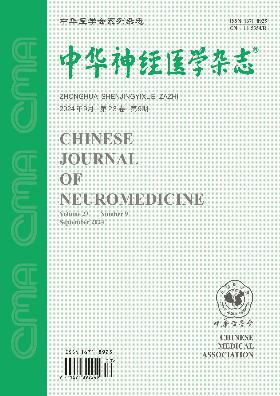Influence of estimated glomerular filtration rate in motor function rehabilitation and short-term prognoses in patients with acute middle cerebral artery infarction
Q4 Medicine
引用次数: 0
Abstract
Objective To investigate the influence of estimated glomerular filtration rate (eGFR) in rehabilitation of motor function and short-term prognoses in patients with acute middle cerebral artery (MCA) infarction. Methods Seventy-four patients with acute MCA infarction, admitted to Department of Neurology from March 2016 to September 2018, and then, accepted rehabilitation training for 4 weeks in Department of Rehabilitation medicine, were recruited. Modification of Diet in Renal Disease was used to evaluate the eGFR instead of renal function; according to the results, these patients were divided into normal renal function group and mild-moderate renal dysfunction group. National Institute of Health Stroke Scale (NIHSS) was used to assess the neurologic function. Fazekas scale was used to assess degrees of leukoaraiosis. Fugl-Meyer Motor Function Assessment (FMA) was used to assess motor functions before rehabilitation treatment and 90 d after onset. Modified Barthel Index (MBI) was used to assess activity of daily living 90 d after onset. According to MBI scores, the patients were divided into good prognosis group (MBI scores>60) and poor prognosis group (MBI scores≤60); multivariate Logistic regression analysis was used to confirm the risk factors affecting prognoses 90 d after onset. Results Among 74 enrolled patients, 40 were classified as normal renal function group and 34 as mild-moderate renal dysfunction group; patients in the mild-moderate renal dysfunction group had significantly higher level of blood urea nitrogen, proportion of silent lacunar cerebral infarction and Fazekas scale scores, and had statistically lower FMA scores and MBI 90 d after onset than normal renal function group (P<0.05). Among the 74 patients, good prognosis was found in 32 patients and poor prognosis in 42 patients; multivariate Logistic regression analysis found that age, eGFR (OR=0.944, P= 0.011, 95%CI: 0.903-0.987), baseline NIHSS scores, and Fazekas scale scores were risk factors affecting prognoses 90 d after onset. Conclusion In acute MCA infarction patients, eGFR can influence the rehabilitation of motor function and short-term prognoses. Key words: Cerebral infarction; Middle cerebral artery; Estimated glomerular filtration rate; Motor function; Rehabilitation; Short-term prognosis估计肾小球滤过率对急性大脑中动脉梗死患者运动功能康复和短期预后的影响
目的探讨肾小球滤过率(eGFR)对急性大脑中动脉梗死患者运动功能康复及短期预后的影响。方法选取2016年3月~ 2018年9月神经内科收治的74例急性MCA梗死患者,在康复医学科接受为期4周的康复训练。肾脏疾病患者的饮食改变被用来评估eGFR而不是肾功能;根据结果将患者分为肾功能正常组和轻中度肾功能不全组。采用美国国立卫生研究院卒中量表(NIHSS)评估神经功能。采用Fazekas评分法评定白化程度。采用Fugl-Meyer运动功能评估(FMA)评估康复治疗前和发病后90 d的运动功能。采用改良Barthel指数(MBI)评价发病后90 d的日常生活活动能力。根据MBI评分将患者分为预后良好组(MBI评分>60)和预后差组(MBI评分≤60);多因素Logistic回归分析确定影响发病后90 d预后的危险因素。结果74例患者中,肾功能正常组40例,轻中度肾功能不全组34例;轻中度肾功能不全组患者血尿素氮水平、无症状腔隙性脑梗死比例、Fazekas评分均显著高于正常肾功能组,发病后90 d FMA评分、MBI评分均显著低于正常肾功能组(P<0.05)。74例患者中预后良好32例,预后不良42例;多因素Logistic回归分析发现,年龄、eGFR (OR=0.944, P= 0.011, 95%CI: 0.903 ~ 0.987)、基线NIHSS评分、Fazekas量表评分是影响发病后90 d预后的危险因素。结论急性MCA梗死患者eGFR可影响运动功能的恢复和短期预后。关键词:脑梗死;大脑中动脉;估计肾小球滤过率;运动机能;康复;短期预后
本文章由计算机程序翻译,如有差异,请以英文原文为准。
求助全文
约1分钟内获得全文
求助全文
来源期刊

中华神经医学杂志
Psychology-Neuropsychology and Physiological Psychology
CiteScore
0.30
自引率
0.00%
发文量
6272
期刊介绍:
 求助内容:
求助内容: 应助结果提醒方式:
应助结果提醒方式:


